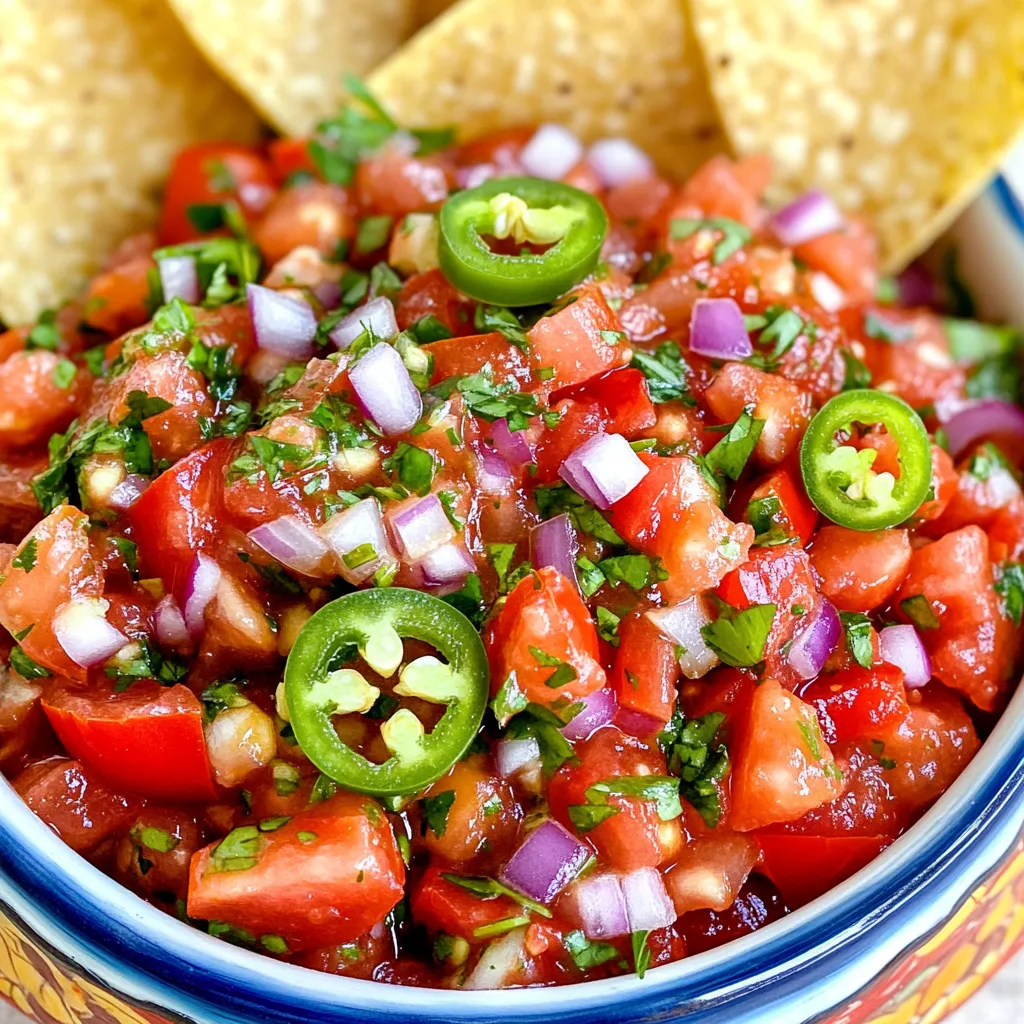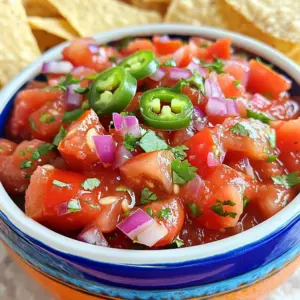Ready to elevate your canning game? In this simple recipe guide, I’ll share the best homemade salsa for canning that will leave your taste buds dancing. With fresh ingredients and easy steps, you can create a vibrant salsa that captures the essence of summer. Whether you prefer it mild or spicy, I’ve got tips to help you make it just right. Let’s dive in and embrace the joy of homemade salsa!
Ingredients
Key Ingredients for Best Homemade Salsa
To make the best homemade salsa, you need fresh and tasty items. Here are the key ingredients:
– 10 medium ripe tomatoes, diced
– 1 large red onion, finely chopped
– 4 cloves garlic, minced
– 2 jalapeño peppers, seeds removed and finely chopped
– 1 red bell pepper, diced
– 1/2 cup fresh cilantro, chopped
– Juice of 1 lime
– 1 teaspoon ground cumin
– 1 teaspoon smoked paprika
– Salt, to taste
– 1/4 teaspoon freshly ground black pepper
– 1 tablespoon olive oil
– 1 cup apple cider vinegar
These ingredients create a fresh and lively taste. They blend well, making your salsa delicious.
Optional Ingredients for Added Flavor
You can boost the flavor of your salsa with some optional items. Consider adding:
– 1 teaspoon sugar for sweetness
– 1/2 teaspoon chili powder for extra heat
– Corn or black beans for texture
– Diced mango or peach for sweetness
These ingredients can help your salsa stand out. You can mix and match them based on your taste.
Ingredient Substitutions
If you can’t find some ingredients, don’t worry! Here are some easy swaps:
– Use canned tomatoes if fresh ones are not available.
– Red onion can be replaced with yellow onion.
– Any mild pepper can work instead of jalapeños.
– For lime juice, you can use lemon juice.
These substitutions can make it easier to prepare your salsa. You can still enjoy great flavors without stress.
Step-by-Step Instructions
Preparing the Ingredients
Start by washing all your veggies. Clean tomatoes, onions, and peppers thoroughly. Dice the tomatoes into small pieces. Chop the onion finely for a good mix. Mince the garlic cloves to release their strong flavor. For the jalapeños, remove the seeds and chop them finely too. Dice the red bell pepper into small bits.
Mixing and Cooking the Salsa
In a large bowl, combine the diced tomatoes, chopped onion, minced garlic, jalapeños, and red bell pepper. Use a spatula to mix the ingredients well. Next, add in the chopped cilantro, lime juice, cumin, smoked paprika, salt, and black pepper. Stir until everything is blended. Taste your salsa. Adjust the seasoning as needed.
Heat olive oil in a large saucepan over medium heat. Pour your salsa mix into the pan. Bring it to a gentle simmer. Let it cook for 10 to 15 minutes. Stir occasionally to prevent sticking. Once it simmers, remove it from the heat and let it cool a bit.
Canning Process Explained
While the salsa cools, prepare your canning jars. Sterilize them by boiling them in water or using your dishwasher’s hot cycle. Once the jars are ready, pour the warm salsa into them, leaving about half an inch of space at the top.
Use a clean cloth to wipe the rims of each jar. Make sure no salsa gets in the way of a good seal. Place the lids on tightly. Next, process the jars in a water bath canner for 15 to 20 minutes. This step is key for safe storage.
After processing, take the jars out and let them cool on a clean towel. To check the seals, gently press the center of each lid. If it doesn’t pop back, the jar has sealed well. Enjoy your fresh salsa!
Tips & Tricks
Best Practices for Canning Salsa
To can salsa safely, start with fresh ingredients. Choose ripe tomatoes and crisp peppers. Always sterilize your jars before use. This prevents spoilage. Use a water bath canner for best results. Process your jars for 15-20 minutes. This ensures a strong seal. Allow the jars to cool on a towel. Check the lids after cooling. If they don’t pop back, you sealed them well.
Flavor Enhancements and Adjustments
You can make your salsa unique by adding spices. Try adding more jalapeños for heat. A pinch of sugar can balance acidity. If you love garlic, add more than four cloves. Fresh herbs like oregano or basil work well too. Lime juice adds a bright flavor, so don’t skip it. Always taste your salsa before canning. Adjust salt or lime juice as needed.
Troubleshooting Common Issues
Sometimes salsa can be too watery. If this happens, cook it longer to reduce liquid. If it’s too spicy, add sugar or more tomatoes. Overly acidic salsa can be fixed with a pinch of sugar. If jars don’t seal, they may need reprocessing. If you see bubbles after sealing, check the lids. For more tips, check the Full Recipe for guidance.

Variations
Spicy Salsa with Extra Heat
Do you like heat? You can make your salsa spicier! Just add more jalapeños or even some habanero peppers. You can also toss in a pinch of cayenne pepper for an extra kick. This will boost the flavor and make it more exciting. Taste your salsa as you go to find your perfect heat level.
Chunky vs. Smooth Salsa Options
Some people love chunky salsa, while others prefer it smooth. For chunky salsa, simply leave the tomatoes and peppers in larger pieces. If you want smooth salsa, blend the mix in a food processor. Pulse it a few times until you reach your desired texture. Both styles are great, so try them out and see what you like best!
Seasonal Variations Using Fresh Ingredients
Using fresh ingredients can change your salsa game! In summer, add sweet corn or ripe peaches for a sweet twist. In fall, consider adding roasted red peppers or even diced apples. You can also switch herbs with basil or parsley for new flavors. Fresh ingredients bring unique tastes and make each batch special!
Storage Info
How to Store Canned Salsa
To store your canned salsa, keep it in a cool, dark place. A pantry or cupboard works well. Once opened, store the salsa in the fridge. Use an airtight container to keep it fresh. Always label your jars with the date you canned them. This helps track how long they’ve been stored.
Shelf Life and Usage Recommendations
Canned salsa can last up to one year if stored properly. After opening, use it within five to seven days. You can enjoy it on tacos, nachos, or as a dip with chips. For the best taste, eat your salsa sooner rather than later.
Signs of Spoilage
Check for several signs to know if your salsa has spoiled. Look for any bulging lids on jars. This means gas has built up inside. A bad smell or mold on the surface is also a sign of spoilage. If the salsa appears off in color or texture, it’s best to toss it. Always trust your senses when checking food.
FAQs
Can I use frozen tomatoes for salsa?
Yes, you can use frozen tomatoes for salsa. Frozen tomatoes work well, but they may be a bit softer. Thaw them first and drain excess water. This helps keep your salsa from being too watery. Using frozen tomatoes can save time, especially if you have a surplus from the garden. Just remember to chop them up as you would fresh tomatoes.
How long can I keep canned salsa?
Canned salsa can last for up to a year when stored properly. Ensure you keep your jars in a cool, dark place. If you see any signs of spoilage, like bulging lids or strange smells, discard the salsa. Always check jars before using them. This helps keep your salsa safe and tasty.
What is the best way to use leftover salsa?
Leftover salsa has many uses. You can top tacos, nachos, or grilled meats. It also makes a great dip for chips or veggies. Try adding it to scrambled eggs for a spicy breakfast. You can even use it as a base for soups or stews, adding flavor to your dishes. The possibilities are endless!
In summary, we explored homemade salsa from start to finish. We covered key and optional ingredients, step-by-step instructions, and handy tips. You also learned about fun variations and how to store your salsa.
Making salsa from scratch is easy and fun. I hope you feel confident in trying new recipes and flavors. Enjoy your salsa-making journey!

